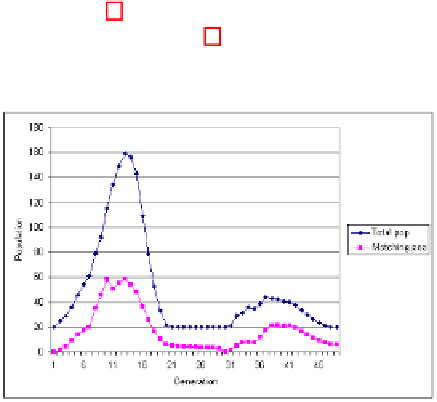Information Technology Reference
In-Depth Information
generated tracker population from generation 1. A2 was then presented from
generations 30 to 40. Figure 2 illustrates the total tracker population in response
to these presentations, whilst Figure 3 shows the population of trackers that
specifically match trends T1 to T7.
Fig. 2.
Total Tracker and total matching tracker populations with no memory feedback
Regarding the presentation of A1, Table 2 shows the TEA is able to identify
and develop memory trackers that map with 100% success to trends T1, T2 and
T3 for each of the 10 runs. There are no redundant price values in the memory
pool resulting in 100% memory eciency. However the TEA is less successful in
indentifying trends T4 to T7 from the subsequent presentation of A2.
The secondary response in Figure 2 is minimal because no memory of the
trends from A1 are carried forward in the system, resulting in the TEA having
to relearn the trends presented. This led to a poor mapping to A2's trends due
to their increased number and complexity.
Trends T1 and T2 were again recognised within A2 and the new trend T4
was identified with 60% success across the 10 runs, however the remaining trends
(T5, T6 and T7) were only rarely detected. In total 39 (55.7%) of the 70 possible
trends were found across the 10 runs, with 3.2% memory ineciency.
6.2
Experiment 2. Long Term Memory Pool Interaction
In this experiment the tracker population is replaced with clones from the mem-
ory pool in generation 30. This provides the potential to learn from the trends
memorised in response to A1, to create associations with the novel trends in
A2. Table 2 shows feedback from the memory pool has a significant impact on
the performance of the TEA compared to experiment 1. The total number of
trends now mapped by memory trackers increases by 43.6% to 56 trends, giving
a detection rate of 80% compared to the previous coverage of 55.7%. The TEA
is now able to consistently detect trends T4, T5, and T6 and even manages to
identify the elusive T7 with a 30% success rate. Memory ineciency fell to 2.1%
with 3 redundant price values included in the memory population.



